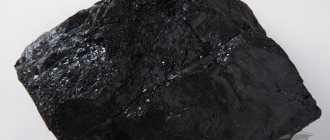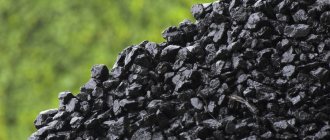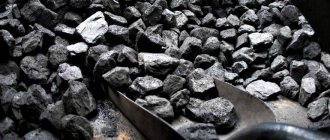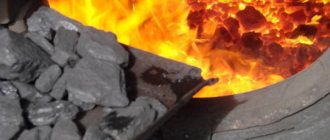Definition of the term synthetic fuel code
The term "synthetic fuel" has several different meanings and can include different types of fuel. The traditional definition set by the International Energy Agency defines "synthetic fuels" as any liquid fuel derived from coal or natural gas. The US Energy Information Association defines synthetic fuels in its 2006 annual report as fuels derived from coal, natural gas, biomass or animal feed by chemical conversion into synthetic oil and/or synthetic liquid products. Numerous definitions of synthetic fuel include fuels produced from biomass as well as industrial and municipal waste. On the one hand, “synthetic” means that the fuel is produced artificially. Unlike synthetic fuel, conventional fuel is usually obtained by separating crude oil into separate fractions (distillation, rectification, etc.) without chemically modifying the components. However, various chemical processes can also be used in the production of traditional fuels. The term “synthetic” can emphasize, on the other hand, that the fuel was produced by chemical synthesis processes, that is, the production of higher-level compounds from several lower compounds. This definition applies in particular to XtL fuels, in which the feedstock is first decomposed into synthesis gas of lower compounds (H2, CO, etc.) in order to obtain higher hydrocarbons (Fischer-Tropsch synthesis). However, even with conventional fuels, chemical processes can be part of the production process. For example, hydrocarbons with carbon chains that are too long can be broken down into shorter chain products, such as those found in gasoline or diesel fuel, through so-called cracking. As a result, depending on the definition, it may not be possible to clearly distinguish conventional from synthetic fuels. Although there is no precise definition, the term "synthetic fuel" is generally limited to XtL fuel. The difference between synthetic and alternative fuels lies in the method of application of the fuel. That is, alternative fuels may require more extensive engine or fuel system modifications, or even the use of a non-traditional engine type (such as steam).
What makes it possible to ensure high heat transfer from smokeless briquettes? And how did you measure it?
Sergey Stepanov:
To measure heat transfer, 10 kilograms of briquettes were burned in a household boiler, and the supply of useful heat (hot water) was determined using a heat meter.
The high efficiency of the boiler is ensured by the fact that the boiler operates evenly most of the time. When burning coal, the combustion mode is different - first there is a peak heat release, then attenuation. Therefore, with coal, most of the heat simply flies away into the chimney.
By the way, when we talk about high heat transfer and fuel economy, it is important to understand that you need to load briquettes in the same volume as you usually load coal. The fact that you need 1.5-2 times less briquettes for heating means that you will have to load fuel 1.5-2 times less often. There is no need to reduce the single portion of loading!
There is no need to reduce the single portion of loading!
Main coal products
The most conservative estimates indicate that there are 600 types of coal products. Scientists have developed various methods for obtaining processed coal products. The processing method depends on the desired end product. For example, to obtain clean products, the primary products of coal processing - coke oven gas, ammonia, toluene, benzene - use liquid washing oils. Special devices ensure sealing of products and protecting them from premature destruction. Primary processing processes also involve the coking method, in which coal is heated to a temperature of +1000°C with the access to oxygen completely blocked. Upon completion of all necessary procedures, any primary product is further purified. Main products of coal processing:
- naphthalene
- phenol
- hydrocarbon
- salicylic alcohol
- lead
- vanadium
- germanium
- zinc.
Without all these products, our life would be much more difficult. Take the cosmetics industry, for example, it is the most useful area for people to use coal processing products. A coal processing product such as zinc is widely used to treat oily skin and acne. Zinc and sulfur are added to creams, serums, masks, lotions and tonics. Sulfur eliminates existing inflammation, and zinc prevents the development of new inflammations. In addition, medicinal ointments based on lead and zinc are used to treat burns and injuries. An ideal assistant for psoriasis is the same zinc, as well as clay products of coal. Coal is the raw material for creating excellent sorbents, which are used in medicine to treat diseases of the intestines and stomach. Sorbents containing zinc are used to treat dandruff and oily seborrhea. As a result of a process such as hydrogenation, liquid fuel is produced from coal at enterprises. And the combustion products that remain after this process are ideal raw materials for a variety of building materials that have fire-resistant properties. For example, this is how ceramics are created.
| Direction of use | Brands, groups and subgroups |
| 1. Technological | |
| 1.1. Layer coking | All groups and subgroups of brands: DG, G, GZhO, GZh, Zh, KZh, K, KO, KSN, KS, OS, TS, SS |
| 1.2. Special preparation processes for coking | All coals used for layer coking, as well as grades T and D (DV subgroup) |
| 1.3. Production of generator gas in stationary gas generators: | |
| mixed gas | Brands KS, SS, groups: ZB, 1GZhO, subgroups - DGF, TSV, 1TV |
| water gas | Group 2T, as well as anthracites |
| 1.4. Production of synthetic liquid fuels | Brand GZh, groups: 1B, 2G, subgroups - 2BV, ZBV, DV, DGV, 1GV |
| 1.5. Semi-coking | Brand DG, groups: 1B, 1G, subgroups - 2BV, ZBV, DV |
| 1.6. Production of carbon filler (thermoanthracite) for electrode products and foundry coke | Groups 2L, ZA, subgroups - 2TF and 1AF |
| 1.7. Production of calcium carbide, electrocorundum | All anthracites, as well as subgroup 2TF |
| 2. Energy | |
| 2.1. Pulverized and layer combustion in stationary boiler plants | Weight of brown coals and atracites, as well as bituminous coals not used for coking. Anthracites are not used for flare-bed combustion |
| 2.2. Combustion in reverberatory furnaces | Brand DG, i group - 1G, 1SS, 2SS |
| 2.3. Combustion in mobile heating units and use for municipal and domestic needs | Grades D, DG, G, SS, T, A, brown coals, anthracites and hard coals not used for coking |
| 3. Production of building materials | |
| 3.1. Lime | Brands D, DG, SS, A, groups 2B and ZB; grades GZh, K and groups 2G, 2Zh not used for coking |
| 3.2. Cement | Brands B, DG, SS, TS, T, L, subgroup DV and grades KS, KSN, groups 27, 1GZhO not used for coking |
| 3.3. Brick | Coals not used for coking |
| 4. Other production | |
| 4.1. Carbon adsorbents | Subgroups: DV, 1GV, 1GZHOV, 2GZHOV |
| 4.2. Active carbons | Group ZSS, subgroup 2TF |
| 4.3. Ore agglomeration | Subgroups: 2TF, 1AV, 1AF, 2AV, ZAV |
Coal
Processing of this type of raw material is carried out in three directions: hydrogenation, coking and incomplete combustion. Each of these types involves the use of a special technological process.
Coking involves keeping the raw material at a temperature of 1000-1200 o C, where there is no access to oxygen. This process allows for complex chemical transformations, which result in the formation of coke and volatile products. The first one, in a cooled state, is sent to metallurgy enterprises. The volatile products are cooled, after which coal tar is obtained. There are still many uncondensed substances remaining. If we talk about why oil is better than coal, it should be noted that much more finished products are obtained from the first type of raw material. Each of the substances is sent to a specific production.
At the moment, oil is even being produced from coal, which makes it possible to obtain much more valuable fuel.
Coal appeared on planet Earth about 360 million years ago. Scientists called this segment of our history the Carboniferous or Carboniferous period. At the same time, the appearance of the first terrestrial reptiles and the first large plants was recorded. Dead animals and plants decomposed, and a colossal amount of oxygen actively contributed to the acceleration of this process. Now on our planet there is only 20% oxygen, but at that time animals breathed deeply, because the amount of oxygen in the Carboniferous atmosphere reached 50%. It is this amount of oxygen that we owe to the modern wealth of coal deposits in the bowels of the Earth. But coal is not everything. Due to various types of processing, a huge number of different useful substances and products are obtained from coal. What is made from coal? This is exactly what we will talk about in this article.
Obtaining raw materials for the production of combustible alcohol at home
The biggest problem with creating flammable alcohol at home now, or in some hypothetical, apocalyptic future, is the raw material. To make a mash that can be distilled into fuel alcohol, you need some grain or other plant material in large quantities. If you have a place to grow raw materials, there will be significantly fewer problems in monetary terms.
Ethanol is mainly made from corn. From every 40 acres it is possible to produce up to 1500 liters of ethyl alcohol per year. Among other crops, millet showed even greater efficiency; from the same area in 1 year, the yield exceeded 2200 liters of ethyl alcohol. Under ideal conditions, you can get 4500 liters with millet.
In the absence of acreage for growing corn, millet, sugar beets and other types of cultivated plants, producing alcohol at home will not be a viable project.
Solid and gaseous fuels edit code
In some third world countries, firewood and charcoal are still the main fuel available to the population for heating and cooking (about half of the world's population lives this way). This in many cases leads to deforestation, which in turn leads to desertification and soil erosion. One of the ways to reduce the population's dependence on wood sources is to introduce technology for briquetting agricultural waste or household waste into fuel briquettes. Such briquettes are produced by pressing a slurry obtained by mixing waste with water on a simple lever press, followed by drying. This technology, however, is very labor-intensive and requires the availability of a source of cheap labor. A less primitive option for producing briquettes is to use hydraulic pressing machines.
Some gaseous fuels can be considered variants of synthetic fuels, although this definition may be controversial since engines using such fuels require significant modification. One of the widely discussed options for reducing the contribution of motor vehicles to the accumulation of carbon dioxide in the atmosphere is the use of hydrogen as a fuel. Hydrogen engines do not pollute the environment and emit only water vapor. Hydrogen-oxygen fuel cells use hydrogen to directly convert the energy of a chemical reaction into electrical energy. Since hydrogen is produced either by methods that require large amounts of electricity, or by the oxidation of hydrocarbon fuels, the environmental and, especially, economic advantages of such fuel are highly controversial.
Full article Hydrogen energy
.
Dimethyl etheredit | edit code
Dimethyl ether is obtained by dehydration of methanol at 300-400 °C and 2-3 MPa in the presence of heterogeneous catalysts - aluminosilicates. The degree of conversion of methanol into dimethyl ether is 60%, into zeolites - almost 100%. Dimethyl ether is an environmentally friendly fuel without sulfur content, and the emission of nitrogen oxides in exhaust gases is 90% less than that of gasoline. The cetane number of dimethyl diesel is more than 55, while that of classic petroleum diesel is from 38 to 53. The use of dimethyl ether does not require special filters, but it requires alteration of the power supply systems (installation of gas equipment, adjustment of mixture formation) and engine ignition. Without modification, it can be used on cars with LPG engines with a 30% methanol content in the fuel.
The calorific value of DME is about 30 MJ/kg, for classical petroleum fuels it is about 42 MJ/kg. One of the features of the use of DME is its higher oxidizing ability (due to the oxygen content) than that of classical fuel.
In July 2006, the National Development and Reform Commission (NDRC) (China) adopted a standard for the use of dimethyl ether as a fuel. The Chinese government will support the development of dimethyl ether as a possible alternative to diesel fuel. In the next 5 years, China plans to produce 5-10 million tons of dimethyl ether per year.
Cars with engines running on dimethyl ether are being developed by KAMAZ, Volvo, Nissan and the Chinese company Shanghai Automotive.
Oil
If we further understand what is obtained from coal and oil, then it is worth mentioning the diesel fraction of oil refining, which usually serves as fuel for diesel engines. Fuel oil contains high-boiling hydrocarbons. Various lubricating oils are usually obtained from fuel oil through distillation under reduced pressure. The residue that exists after processing fuel oil is usually called tar. A substance such as bitumen is obtained from it. These products are intended for use in road construction. Fuel oil is also often used as boiler fuel.
How is gasoline made?
In order to obtain fuel, it is necessary to carry out a number of operations with crude oil. The thing is that the initial product consists of a mixture of various hydrocarbons
It is also important to understand that each molecule of this substance contains a different number of carbon atoms. To explain simply, each of these molecules has its own height and weight
To obtain gasoline molecules, which are the simplest and lightest, it is necessary to heat crude oil until the more complex and heavier particles are broken down into simpler ones - gasoline. In other words, to answer the question of how gasoline is made, we can say that it is obtained by heat treating crude oil. However, it is worth adding some smaller processes to this process, such as cleaning and recycling.
Story
NYMEX West Texas Intermediate oil prices
During World War II, Germany largely, up to 50% in some years, met its fuel needs by creating production facilities for converting coal into liquid fuels. According to “Hitler’s personal architect” Albert Speer, Germany was technically defeated on May 12, 1944, when, as a result of massive Allied bombing, 90% of the factories producing synthetic fuel were destroyed.
Similarly, South Africa, with the same goals, created the company Sasol Limited, which during Apartheid helped the economy of this state to function successfully despite international sanctions.
In the US, producers of such fuels often receive government subsidies and therefore are sometimes made from a mixture of coal and biological waste. Such methods of obtaining government subsidies have been criticized by the “greens” as an example of abuse of the tax system by corporations. Synthetic diesel fuel, produced in Qatar from natural gas, has a low sulfur content and is therefore blended with conventional diesel fuel to reduce the sulfur level in the mixture, which is necessary for marketing diesel fuel in those US states where there are particularly high fuel quality requirements (for example in California).
| Synthetic liquid fuels and gas from solid fossil fuels are now produced on a limited scale. Further expansion of synthetic fuel production is hampered by its high cost, which significantly exceeds the cost of petroleum-based fuels. Therefore, new economical technical solutions in the field of synthetic fuel are now being intensively searched. The search is aimed at simplifying known processes, in particular, at reducing the pressure during coal liquefaction from 300-700 atmospheres to 100 atmospheres and below, increasing the productivity of gas generators for processing coal and oil shale, and also developing new catalysts for the synthesis of methanol and gasoline based on it. |
Currently, the use of Fischer-Tropsch technology is possible only at stable oil prices above $50-55 per barrel.
extension
Gasoline advertising since 1937
From mid-1934, world mineral oil prices rose to such an extent that the synthetic fuel industry suddenly became competitive. The reason for the rapid rise in crude oil prices was the private sector, but above all the growing global military level of motorization. Among other things, APOC, whose main owner was the British state, took over fuel supplies for Mussolini's Abyssinian War, despite the League of Nations embargo. At that time, with an annual consumption of 3.7 million tons of mineral oil, Germany depended on 65-70 percent of oil imports, 75 percent of which came from British and American companies. A year later, 50 percent of oil imports for the German Reich failed. This was the first “oil shock” in German history.
From a German point of view, this development clearly favored the construction and expansion of hydrogenation plants. In October 1934 (Brabag) was founded, which was to produce about 740,000 tons of synthetic fuel per year at its hydrogenation plants in Magdeburg and Böhlen from 1936 and in Zeitz from 1939 under license using the IG process. At the same time, IG Farben increased production at the Leuna plant and built additional hydrogenation plants of its own at various locations.
The state-owned mining company Hibernia also signed a license agreement with IG Farben and commissioned Germany's first hydrogenation plant to liquefy hard coal in Scholven in 1936. The synthetic gasoline produced here was sold by the Benzene Association as
Leuna
gasoline and under the brand name
Bevaulin
, later
Aralin
. In addition, since 1936, in competition with IG Farben, the first large enterprises operating using Fischer-Tropsch technology under license from Ruhrchemie began producing synthetic fuels. In fact, almost all major German energy suppliers built their own hydrogenation and synthesis plants in the subsequent period.
During the Spanish Civil War (1936–1939), world oil prices rose sharply. The Soviet Union supplied fuel to the Republicans, and British and American oil companies provided fuel supplies to the national Spanish throughout the war. The governments of London and Washington simultaneously provided the latter with extensive loans for the purchase of gasoline, which was contrary to the neutrality resolutions of both countries.
Leading British and American oil companies did not hesitate to expand their business relationships with Nazi Germany, in some cases even at the very beginning of the war. For example, the construction of the Poelitz hydrogenation plant was jointly planned by Shell, Standard Oil and IG Farben in 1937 and implemented in 1939. The annual capacity of this plant was 700,000 tons, which exceeded the capacity of all other hydrogenation plants. The initiative for this came from IG Farben's international partners. Standard Oil and Shell were also involved in six other hydrogenation plants in Germany. Additionally, in 1939, a third of all gas stations in Germany were owned by Standard Oil, which contributed significantly to the sale of synthetic gasoline.
By 1943, a total of 23 hydrogenation and synthesis plants had been built in the German sphere of influence, nine using Ruhrchemie's Fischer-Tropsch technology and 14 using IG Farben's high-pressure hydrogenation technology. Although armed with a huge expansion of industrial coal chemistry in Germany, synthetic fuel production could not even come close to achieving independence from oil imports at the start of the war and in the subsequent period. From mid-1944, shortly before the Normandy invasion, production fell sharply as a result of targeted Allied air strikes on German oil centers, refineries and synthetic hydrogenation plants, and fell to 1920s levels by the end of the war.
Synthetic gasoline called Leuna petrol
has long ceased to exist. Already in September 1939, all brands disappeared from German gas stations. With the transition to a war economy during World War II and the resulting control by the central government, all petroleum distribution companies were combined into the Mineral Oil Distribution Working Group (AMV), and only unbranded gasoline was sold with a fuel certificate or voucher for purchase .
Ethers
Esters are colorless, mobile, low-boiling liquids with a characteristic odor. Methyl tert-butyl ether (MTBE) is currently considered the most promising anti-knock agent. In Russia it is allowed to add it to automobile fuels in amounts up to 15%. The limitations are caused by the characteristics of the performance characteristics: relatively low heat of combustion and high aggressiveness towards rubber. According to road test results, unleaded gasoline containing 7-8% MTBE outperforms leaded gasoline at all driving speeds. The addition of 10% MTBE to gasoline increases the octane number according to the research method by 2.1–5.9 units, and 20% by 4.6–12.6 units, and therefore it is more effective than such well-known additives as alkyl gasoline and methanol . The use of fuel with methyl tert-butyl ether somewhat improves the power and economic performance of the engine. MTBE is a colorless, transparent liquid with a pungent odor. The boiling point is 54-55°C, the density is 0.74 g/cm3. The octane number according to this method is 115-135 points. World production of MTBE amounts to tens of millions of tons per year.
As potential antiknock agents, it is possible to use ethyl tert-butyl ether, tert-amyl methyl ether, as well as methyl ethers obtained from C6-C7 olefins.
Properties of some esters.
| Ether | Formula | OCHIM | BSMM | OVSD | Boiling point, °С |
| MTBE | CH3-OC(CH3)3 | 118 | 110 | 114 | 55 |
| ETBE | C2H5-OC(CH3)3 | 118 | 102 | 110 | 70 |
| MTAE | CH3-OC(CH3)2C2H5 | 111 | 98 | 104,5 | 87 |
| DIPE | (CH3)2CH-O-CH(CH3)2 | 110 | 99 | 104,5 | 69 |
To obtain AI-95 and AI-98 gasolines, the additives MTBE or its mixture with tert-butyl alcohol, called Faterol - the trade name of Octane-115, are usually used. The disadvantage of such oxygen-containing components is the volatilization of esters in hot weather, which leads to a decrease in octane number.
Environmental considerations[edit]
Main article: Environmental impact of the coal industry
Typically, coal liquefaction processes are associated with significant CO2 emissions during the gasification process or the production of the necessary process heat and electricity introduced into liquefaction reactors [10], thereby releasing greenhouse gases that can contribute to anthropogenic global warming. This is especially true if coal liquefaction is carried out without any carbon capture and storage technology. [21] Technically feasible low-emission CTL plant configurations exist. [22]
Another adverse environmental impact is the high water consumption in the water gas shift or steam methane reforming reaction. [10]
Controlling CO2 emissions at Erdos CTL, a plant in Inner Mongolia with a carbon capture and storage demonstration project, involves injecting CO2 into the saline aquifer of the Erdos Basin at a rate of 100,000 tons per year. [23] [ 3rd party source required
] As of the end of October 2013, the accumulated amount of CO 2 injected since 2010 was 154,000 tons, which reached or exceeded the calculated value.
[24] [ 3rd party source needed
]
For example, in the United States, renewable fuel standards and low carbon fuel standards such as those adopted by the state of California reflect the growing demand for low carbon footprint fuels. In addition, US law limits the military's use of alternative liquid fuels to only those fuels that have life-cycle greenhouse gas emissions less than or equal to those of their conventional oil equivalent, as required by Section 526 of Energy Independence. and the Security Act (EISA) 2007. [25]
Liquid fuel from gases
It is difficult to imagine that from such simple substances as carbon monoxide (that is, carbon monoxide) and hydrogen, complex organic compounds and a wide variety of liquid fuels can be obtained.
To obtain liquid fuel, you need to have a mixture of these gases, in which for every part of carbon monoxide there would be two parts of hydrogen. This mixture is obtained in special devices - gas generators. A mixture of water vapor and air is blown through a layer of hot coke. Oxygen in the air combines with carbon to form carbon monoxide. This process is called coal gasification. When water molecules decompose, hydrogen is released. A mixture of hydrogen and carbon monoxide is sent to refrigerators. From here the so-called water gas goes into the reactor. At a temperature of 200°, under the influence of the most active catalysts - cobalt or nickel - carbon monoxide and hydrogen enter into a chemical compound. Complex heavy substances are formed from a large number of light gas molecules.
Catalysts not only contribute to the formation of simple compounds of carbon and hydrogen, but also influence further complexity - the polymerization of molecules: carbon atoms are connected in chains, rings, and are overgrown with hydrogen atoms. A wide variety of hydrocarbons re-emerge - from light gases (starting from methane) to solid, high-melting paraffins, containing up to 100 carbon atoms in each molecule. Approximately 60% of the initially taken gas mixture turns into liquid fuel. This is artificially prepared oil, not much different from ordinary, natural oil.
Let's enter the workshop where fuel synthesis takes place. The iron apparatus is surrounded by complex interweavings of thick pipes. The workshop is quiet and deserted. Special devices automatically control the process and record temperature and pressure themselves. It is interesting that the process of formation of liquid fuel occurs at normal atmospheric pressure and a temperature of only about 200°. When synthesizing fuel from gases, expensive equipment is not needed to create high pressures and temperatures. This distinguishes synthesis favorably from coal hydrogenation.
Soviet industry now produces hundreds of thousands of diesel engines running on mixtures of high-boiling heavy oil fuel.
There are more and more powerful 25-ton trucks - dump trucks, motor ships, excavators and other machines with diesel engines installed. The car and tractor fleet is increasing.
The production of artificial diesel fuel is also continuously growing.
This is how chemists manage processes to obtain the right grade of fuel.
The advantages of this method open up great prospects for it. Liquid fuel can be obtained from any, even the lowest-grade brown coal.
Preliminary gasification of fuel makes it possible to obtain gasoline from oil shale and even peat, not to mention the use of natural gas for this purpose. In 1951 - 1955, new plants were built to produce synthetic liquid fuel from coal, shale and peat. In the Estonian SSR alone, based on local shale, the production of such fuel will increase by 80% over the five-year period.
S. Gushchev Fig. B, Dashkov and A. Katkovsky magazine “Technology for Youth” No. 7, 1954
Hydrogenation process
To successfully carry out the process and obtain up to 800 kg of liquid fuel from 1 ton of raw materials, brown or hard coal is taken. The main condition for effectively achieving results is the presence of 35% volatile substances in coals. Before processing, they are ground, crushed to a dusty fraction, and then dried. After this, the coal fraction is mixed with fuel oil or heavy oils to form raw materials in the form of a paste.
During the destructive hydrogenation process, the technology involves direct addition of the missing hydrogen to the coal.
To do this, the raw materials are placed in a special autoclave and heated. In this case, the pressure inside the vessel reaches 200 Bar, and the temperature – 500 °C. Moreover, there must be substances in the chemical reaction zone - catalysts and solvents. According to this method, the production of gasoline from coal takes place inside an autoclave in 2 stages:
- liquid phase;
- vapor phase.
Several complex chemical reactions take place in a vessel under high pressure and high temperature. In order not to burden the story with specific terms, let us explain in simple words: in the autoclave, coal is saturated with hydrogen and complex organic compounds decompose into simple ones. As a result, after cleaning operations, the output is synthetic diesel fuel or gasoline. This depends on the conditions of the process and the degree of transformation of the coal-oil mixture. But the exit of fuel from the installation is preceded by a number of operations:
- centrifugation;
- semi-coking;
- distillation.
As you can see, it is not possible to set up such a complex production with your own hands. The main difficulty is the equipment; it is unlikely that you will be able to make it yourself. Take, for example, an autoclave, where the pressure is higher than in oxygen cylinders. And in general, such production poses an explosion and fire hazard.
Better than in nature
Back at the end of the last century N.D
Zelinsky drew attention to the difference in the structure of oil molecules. Most of the molecules of high-quality Baku oil are closed rings of carbon atoms, to which hydrogen atoms are attached on the sides
The high quality of fuel primarily depends on this cyclic structure of molecules. Grozny oil contains less naphthenes - cyclic hydrocarbons. It is dominated by molecules of the methane series, stretched in the form of chains of atoms. Gasoline obtained from Grozny oil, when compressed in the engine cylinders, detonated and spontaneously exploded much earlier than the moment when the ignition spark jumped between the electrodes of the spark plug.
This phenomenon caused a lot of trouble for chemists and engine builders, who always sought to increase engine power. The power and efficiency of an engine depends primarily on how strongly the pistons in the cylinder compress the combustible mixture. The compression ratio (that is, the ratio of the volume of the entire cylinder to the volume of the combustible mixture extremely compressed in the cylinder) is one of the most important characteristics of the engine. The higher the compression ratio, the more powerful and economical the engine. If, for example, you increase the compression ratio of a car engine from 5.25 to 10.3, then the car, moving at a speed of 40 km/h, will consume half as much fuel and will travel twice as far on one tank of gasoline.
But here's the problem: the vapors of regular gasoline cannot withstand high compression and detonate. The engine quickly overheats and begins to knock, as if it is about to fall apart. Its power drops sharply.
During detonations, the piston rings and piston crown burn out, and the bearings are destroyed.
These fuel properties are assessed by the so-called octane number. If they say that the octane number of a fuel is 60, this means that its detonation properties are the same as those of a mixture containing 60% isooctane and 40% heptane. These two substances were not taken as a standard by chance: isooctane resists detonation very well (its octane number was therefore set to 100), and heptane, on the contrary, detonates more easily than all other liquid hydrocarbons (its octane number was taken to be 0).
The result is a kind of scale by which you can find out how it detonates and whether this or that type of gasoline is of high quality.
The higher the octane number of gasoline, the stronger the combustible mixture can be compressed in the cylinders without fear of detonation, the more powerful and economical the engine. At first, aircraft engines ran on gasoline with an octane rating of 50-55. The use of 87 octane gasoline in aviation made it possible to increase engine power by 30-35%, and the advent of 100-octane gasoline helped increase engine power by another 15-30%. In other words, modern engines have become almost twice as powerful as “old” engines with the same cylinder capacity.
It would seem that the quality of 100-octane gasoline is the limit set by nature itself. But this limit, like many others, was managed to be crossed by science, armed with advanced technology. Modern airplanes fly on gasoline with an octane rating much higher than 100. There is no oil in the world that contains gasoline of such high quality. Such gasoline can only be obtained artificially - through synthesis.
The synthesis of hydrocarbons has long been a tempting goal for many generations of chemists. Academician N.D. Zelinsky wrote in 1931: “When a chemist gets acquainted with the structure of petroleum hydrocarbons and studies their properties, he cannot help but be surprised at how easily nature has created these amazing forms, which are so difficult to prepare synthetically.”
Nowadays, high-quality liquid fuels are obtained from low-quality gasolines and gases by rearranging straight chains into branched and ringed structures.
Scientific search for an alternative
Although the main fractions are obtained from oil, it turned out that other carbon raw materials can be used for this purpose. This problem was solved by chemists back in 1926. Then scientists Fischer and Tropsch discovered the reduction reaction of carbon monoxide under atmospheric pressure. It was found that in the presence of catalysts, liquid and solid hydrocarbons can be created from a gas mixture. In their chemical composition they were close to products obtained from oil. The result of chemical research was called “synthesis gas”. It turned out quite easily. So much so that it can be repeated at home by any person who did not skip chemistry and physics at school. It was obtained by passing water steam over coal (this is its gasification) or by converting ordinary natural gas (it consists mainly of methane). In the second case, metal catalysts were also used. It should be noted that synthesis gas can be created not only from methane and coal. A promising direction is now considered to be work on the enzymatic and thermochemical processing of plant waste. We should also not forget about the conversion of biogas, that is, volatile substances obtained through the decomposition of organic waste.
Processing waste into fuel in Russia
In January 2022, the country's President V. Putin signed a decree on the creation, which will become the country's unified garbage operator in the form of a public company (PPC); The functions of the founder will be performed by the Ministry of Natural Resources. The operator will deal with state programs for waste management and attract investors for waste disposal projects.
Innovation
Waste processing complexes: For the first time, within the framework of domestic research, the task was set (2011) to combine disparate advanced developments
across many industries.
Several options for environmentally friendly, high-tech waste processing complexes that are competitive on the world market will be developed. Optimization of raw materials, heat, and gas flows
will ensure maximum production of liquid fuel fractions and building materials - without any process waste, except for waste catalytically purified gases. As a result of processing, profitable products will be produced: fuel, additives, construction materials.
At the 1st stage, it is planned to complete the experimental line for research, testing, certification and patenting. This work will be carried out jointly with the Skolkovo Foundation, of which .
It is planned to build mobile or stationary processing complexes
consisting of 1-5 lines of the same type with an annual processing volume of 50-250 thousand tons of prepared solid waste (newly generated and landfill), sorting “tailings”, sludge sediments, peat, coal sludge, wood waste and other organics. As a result of processing, the following commercial products will be produced:
- diesel fuel
- chemical products: (benzene, toluene and nefras or combined BTK fraction),
- cement,
- gas foam concrete.
see also
- Alternative automobile fuel
- Synthetic natural gas
- The methanol economy is a hypothetical future energy economy in which fossil fuels are replaced by methanol.
- Dry distillation
- GTL (Gas-to-liquids) is the process of converting natural gas into high-quality, sulfur-free motor fuels and other (heavier) hydrocarbon products.
- Hydrolysis production
- Biofuel
- Global Energy
- Solar oven is a simple device for using sunlight to cook food without using fuel or electricity.











